F4U Corsair
Corsair in Action
Le Corsair est sans aucun doute avec son design si particulier, le plus célèbre avion de chasse américain de la guerre du Pacifique. A l'origine développé comme avion embarqué il fut en raison d'un choix de conception utilisé durant les premières années de la guerre du Pacifique uniquement comme chasseur basé à terre par le Corps des Marines (en remplacement des Wildcats). En effet les l'US Navy avait reçu ses premiers appareils le 31 juillet 1942, elle avait jugé cet avion inapte à opérer à partir d'un porte-avion en raison de son design. Afin d'accueillir un moteur plus puissant et un réservoir principal plus important, le cockpit sur le modèle de production avait été reculé d'1 m. Cette position très en retrait rendait le pilote presque aveugle quand le nez était en position haute lors des décollages et atterrissages ! Si comme avec les Hellcat ou les Avenger, Le Corsair avait opté pour un poser « trois-points » , dans son cas, cela obligeait le Corsair à évoluer à une vitesse proche de celle du décrochage, qui le rendait instable. De plus il avait tendance à fortement rebondir lors des appontages et si le pilote ratait les brins d'arrêt, avec la crosse d'appontage, la brusque remise des gaz, et le couple important du moteur, tendait à faire tourner l'appareil autour de l'hélice, abaissant l'aile gauche vers le pont qu'elle risquait de toucher et entraîner l'accident. Le Hellcat bien que moins performant, était jugé plus "safe" par les pilotes et fut donc conservé pour les porte-avions. Comme les Marines qui devaient remplacer leur Wildcats obsolètes, opéraient depuis des bases terrestres, les problèmes d'appontage du Corsair étaient pas un problème justement. Il connaîtra donc ses premiers succès aux mains des pilotes de le l'US Marine Coprs. Le Corsair ne sera finalement utilisé ce pour quoi il avait été conçu qu'en 1944 ! Entretemps les Britanniques avaient prouvés que le Corsair pouvait malgré ce problème parfaitement être utilisé sur un porte-avion. Rapide et maniable il fut le chasseur le plus puissant au monde à cette époque. Le Corsair était nettement plus rapide que le F6F Hellcat et à peine moins que le P-47 Thunderbolt. Les trois avions étant tous équipé du R-2800. Néanmoins le P-47 atteignait sa vitesse maximale à 9150 m à l'aide son turbocompresseur à refroidisseur intermédiaire, alors que le F4U-1 atteignait la sienne à 6100 m avec seulement son moteur suralimenté mécaniquement.
The Corsair is no doubt with its distinctive design, the most famous American fighter of the war of the Pacific. Originally developed as a ship-borne aircraft it was due to a choice of design used during the first years of the war of the Pacific only as a land based fighter by the Marine Corps (in lieu of the Wildcats). Indeed the US Navy received its first aircraft on July 31, 1942, it had found the aircraft unfit to operate from an aircraft carrier because of its design. In order to accommodate a more powerful engine and a larger main fuel tank, the cockpit on the production model had been pushed backwards of 1 m. Very back position made almost blind pilot when the nose was in the up position during take-offs and landings! If as with the Hellcat or the Avenger, the Corsair had opted for a "three-point" landing, in its case, this required the Corsair to evolve at a speed close to that of the stall, that made it unstable. If the pilot missed the shutdown strands, with the hook of landing, the sudden release gases, and the torque of the engine, tended to rotate the aircraft around the propeller, lowering the left wing towards the deck that it could touch and cause the accident. The Hellcat although less efficient, was considered more "safe" by the pilots and was thus retained for the aircraft carrier. As the Marines who had to replace their obsolete Wildcats, operated from land bases, the Corsair landing problems were not a problem. It will therefore experience its first success in the hands of the pilots from the the US Marine Corps. The Corsair will eventually be used for what it was designed in 1944! Meanwhile the British had proven that the Corsair could despite this problem perfectly be used on an aircraft carrier. Fast and handy it was the strongest fighter in the world at this time. The Corsair was significantly faster than the F6F Hellcat and barely less than the P-47 Thunderbolt. The three aircraft are all equipped with the R-2800. Nevertheless the P-47 reached its maximum speed at 9150 m with the help of an intercooled turbosupercharger, while the F4U-1 reached its ownat 6100 m with only mechanically supercharged engine.
 |
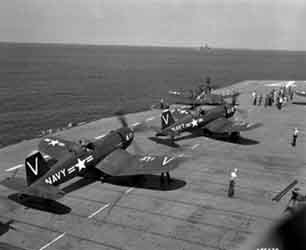 |
Le Corsair fut utilisé comme chasseur
basé à terre avant de devenir un chasseur embarqué
au sein de l'US Navy. |
Corsairs faisant chauffer leur moteur sur le
pont d'envol. |
The Corsair was used
as a land-based fighter before becoming a carrier-based fighter
within the U.S. Navy. |
Corsairs heating their
engine on the flight deck. |
src: aero-web |
src: Classic
Fighters |
Malgré tout durant les premières années de la guerre du Pacifique deux unités de l'US Navy seront équipés de Corsairs; la VF-12 en octobre 1942 et la VF-17 en avril 1943. En avril 1943, la VF-12 passe avec succès la qualification d'appontage mais les Corsairs de cette escadrille seront finalement livrés aux Marines. Seule la VF-17 conserve ses Corsairs mais est retirée de son porte-avion, l'USS Bunker Hill. En novembre 1943, la VF-17 basée dans les îles Salomon, réinstalle les crosses d'appontage à ses Corsairs pour qu'ils puissent atterrir et ravitailler tout en fournissant la couverture aérienne à la task force lors du raid sur Rabaul. Les Corsairs du VF-17 purent ainsi atterri, ravitailler et décoller sur et à partir de leur ancienne base flottante, le Bunker Hill ainsi que sur le USS Essex, le 11 novembre 1943.
Nevertheless during the early years of the Pacific war two units of the U.S. Navy will be equipped with Corsairs; the VF-12 in October 1942 and the VF-17 in April 1943. In April 1943, VF-12 passes the carrier landing qualification but the Corsairs of this squadron will be eventually delivered to the Marines. Only the VF-17 retains its Corsairs, but withdrew from its aircraft carrier, the USS Bunker Hill. In November 1943, VF-17 based in the Solomon Islands, reinstall the stopping hooks of its Corsairs so they can land and refuel while providing air cover for the task force during the raid on Rabaul. The Corsairs of VF-17 could thus landed, refuel and take off to and from their former floating base, Bunker Hill as well as on the USS Essex, November 11, 1943.
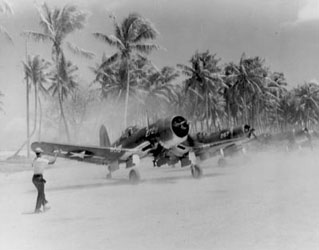 |
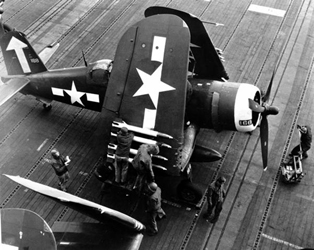 |
Corsairs du Pacifique prêts à
l'assaut. |
Belle vue des roquettes sur cette aile pliée
d'un Corsair. |
Corsairs of the Pacific
ready to attack. |
Beautiful view of the
rockets on this folded wing of a Corsair. |
src: Classic
Fighters |
src: aero-web |
L'US Navy accepte finalement le Corsair comme avion embarqué en avril 1944, après qu'un amortisseur oléopneumatique plus long ait été installé, réduisant à néant sa proportion à rebondir. La première unité cependant à opérer vraiment à partir d'un porte-avion américain, fut la VMF-124 du Corps des Marines sur l'USS Essex. Le véritable déclencheur de la carrière du Corsair sur les porte-avions américains fut l'utilisation de plus en plus massive par les Japonais d'avions Kamikazes. Le Corsair était l'intercepteur le plus apte pour contrer cette menace.
Pourtant le premier combat du Corsair ne fut guère impressionnant. En effet connus sous le nom de massacre de la Saint Valentin, une douzaine de Corsairs de la VMF-124 participèrent le 14 février 1943 à un raid avec des P-40 et des P-48 en soutient de B-24 Liberator contre l'aérodrome japonais de Kahili. Deux Corsairs, quatre P-38, deux P-40 et deux Liberators furent perdus pour seulement 4 Zero japonais ! Mais après coup, les Marines firent un bien meilleur usage de leur nouveau pur-sang et le Corsair démontra bien vite sa supériorité sur ses opposant nippons. Chez les Japonais, le Corsair deviendra légendaire sous le nom de « mort sifflante » en raison du bruit que faisait l'air sur les bords d'attaque des ailes.
The Navy finally agreed to the Corsair as carrier-based aircraft in April 1944, after a longer oleo has been installed, reducing to nil its proportion to bounce. The first unit however to really operate from an American aircraft carrier, was on the USS Essex, Marine Corps VMF-124. The real trigger of the career of Corsair on the U.S. carriers was the more massive use by Japanese of kamikaze aircraft. The Corsair was the interceptor the fittest to counter this threat.
Yet the first fight of the Corsair was hardly impressive. Indeed known as the Saint Valentine's massacre, a dozen Corsairs of VMF-124 participated on February 14, 1943 in a raid with P-40 and P-48 in support of B-24 Liberator against Japanese Kahili airfield. Two Corsairs, four P-38, two P-40 and two Liberators were lost for only 4 Japanese Zero! But afterward, the Marines made a much better use of their new Thoroughbred and the Corsair quickly demonstrated its superiority over its Japanese opponents. Among Japanese, the Corsair will become legendary as the 'wheezing death' because of the noise that did air on the leading edges of the wings.
 |
-wikipedia.jpg) |
Corsair en mauvaise posture après un
appontage raté. |
Le Corsair avec le Hellcat furent les maîtres
des cieux du théâtre Pacifique durant les dernières
années de la guerre. |
Corsair in bad posture
after a missed landing. |
The Corsair with the
Hellcats were the masters of the skies of the Pacific theater during
the last years of the war. |
src: WWII
Vehicles |
src: Wikipedia |
Le Corsair équipa le fameux "Black Sheep Squadron" VMF-214 dirigé par le Major des Marines Gregory "Pappy" Boyington, basé dans les Îles Salomon Cette unité sera rendue encore plus célèbre par une série télévisée (les Têtes brûlées). Le Major Boyington fut crédité de 28 victoires dont 22 sur Corsair (6 sur P-40). Notons que des unités des Marines et de la Navy seront aussi équipés de Corsair version nuit que ce soit à terre ou sur mer. Le Corsair fut également utilisé comme chasseur-bombardier dans le Pacifique et aux Philippines. Le Corsair fit effectivement merveille en appui rapproché lors des opérations de débarquement. Le Corsair était une plate-forme de bombardement très polyvalente capable d'utiliser toutes sortes de bombes explosives, voir du napalm ou des roquettes. Il pouvait transporter une bombe à glissement BAT et des roquettes en même temps. Le Corsair en tant que chasseur-bombardier prit une part importante aux combats de Palaos, Iwo Jima et Okinawa. La configuration des ailes en "W" donnait au Corsair une bonne visibilité du sol en comparaison à une aile droite basse qui pouvait bloquer la visibilité du sol depuis le cockpit.
The Corsair equiped the famous "Black Sheep Squadron" VMF-214 led by the Major of Marines Gregory "Pappy" Boyington, based in the Islands Solomon this unit will be made even more famous by a television series (Baa Baa Black Sheep). Major Boyington was credited with 28 victories including 22 on Corsair (6 on P-40). Note that the Marines and Navy units will be also equipped with Corsair night version, be it on land or sea. The Corsair was also used as a fighter-bomber in the Pacific and the Philippines. The Corsair was actually wonder in close support during landing operations. The Corsair was a versatile bombardment platform able to use all kinds of explosive bombs, see napalm and rockets. It could carry a BAT glide bomb and rockets at the same time. The Corsair as a fighter-bomber took a leading part in the battles of Palau, Iwo Jima and Okinawa. The "W" configuration of the wings gave to the Corsair a good visibility of the ground in comparison to a low right wing that could block the visibility of the ground from the cockpit.
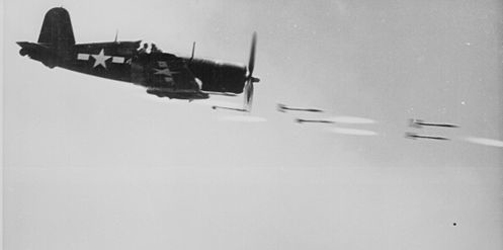 |
 |
Le Corsair fut aussi un redoutable chasseur-bombardier
et avion d'attaque au sol. Ici un tir de roquettes à Okinawa. |
Vue de la célèbre série
TV; les "Têtes brûlées". |
The Corsair was also
a formidable fighter-bomber and ground-attack aircraft. Here a shot
of rockets at Okinawa. |
View of the famous TV
series; the "Baa Baa Black Sheep or Black Sheep Squadron". |
src: Wikipedia |
src: Google |
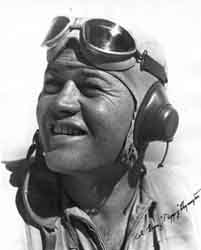 |
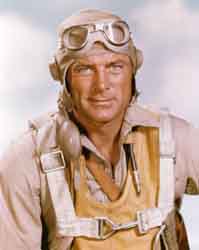 |
Gregory "Pappy"
Boyington, Squadron VMF-214 |
Robert Conrad alias Major
Gregory « Greg or Pappy » Boyington. VMF 214 at Vella
La Cava. |
src: Wikipedia |
src: toutlecine |
Durant le conflit, le Corsair est crédité de 64051 sorties pour l'US Marines Corps et l'US Navy (44% des sorties) dont seulement 9581 sorties à partir de porte-avions. Il est également crédité de 2140 victoires aériennes pour seulement 189 pertes dues aux appareils ennemis (1/11). Le Corsair largua 14171 tonnes de bombes. Pour ce qui est des pertes en dehors des combats aériens, 349 Corsairs furent détruits par la DCA ennemies, 230 furent perdus durant des missions de combat, 692 furent perdus en vol hors missions de combat et 164 furent détruits au sol ou sur le pont d'un porte-avion.
During the conflict, the Corsair is credited of 64051 operational sorties for the US Marine Corps and US Navy (44% of operational sorties) which only 9581 operational sorties from aircraft carriers. It is also credited with 2140 aerial victories for only 189 losses by enemy aircraft (1/11). The Corsair dropped 14171 tons of bombs. Except losses during dogfights, 349 Corsairs were destroyed by the enemies Flak, 230 were lost during combat missions, 692 were lost non-combat flights, and 164 were destroyed on the ground or on the deck of a carrier.
Sources: